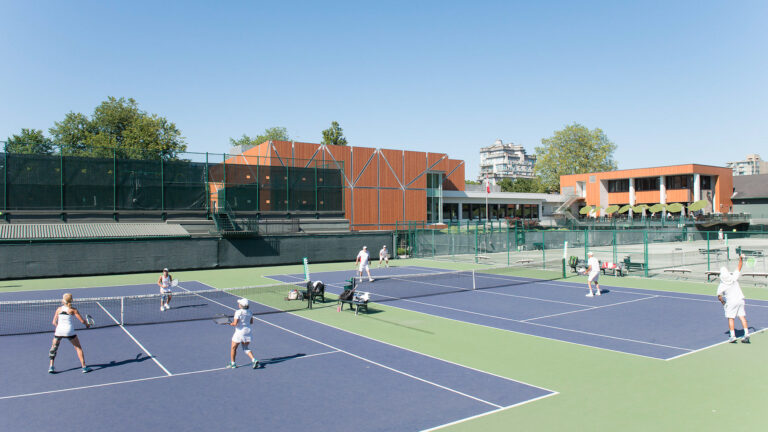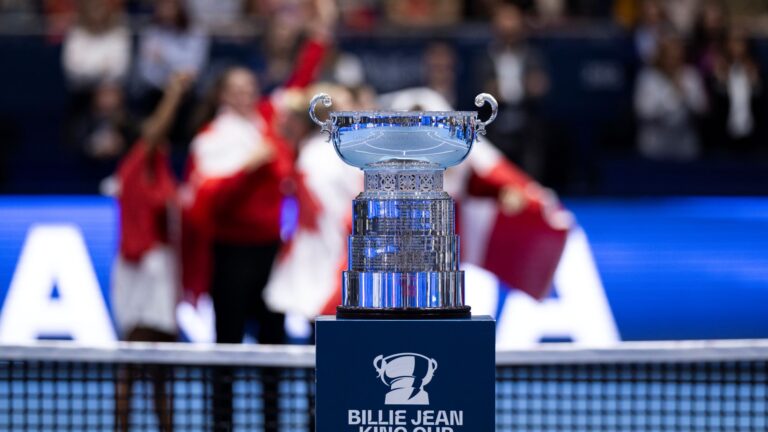
TEBBUTT: DAVIS CUP – STAN’S THE MAN

Switzerland won its first ever Davis Cup on Sunday when Roger Federer clinched the third point with a brutal 6-4, 6-2, 6-2 demolishing of Richard Gasquet.
Moments after his win, in a courtside interview, he said about his No. 1 teammate, “Stan put in so much effort over the years and he played an unbelievable weekend, that’s what gave me the opportunity today. I’m very much aware of that…this one’s for the boys.”
Wawrinka capped an amazing year that started with a Grand Slam title at the Australian Open, slumbered through some dismal results in the summer and fall, and came on gangbusters to be the main man for the Swiss in the Davis Cup final in Lille, France. Had he not beaten Jo-Wilfried Tsonga 6-1, 3-6, 6-3, 6-2 in the opening singles on Friday, the Swiss would likely have been down 0-2 after the first day because Federer, with his back problem, was obviously not ready to play his best in the second singles, losing 6-1, 6-4, 6-3 to Gael Monfils.
But the back semi-miraculously got better as the Monfils match went on and he was in normal operating form during Saturday’s doubles when he and Wawrinka simply outclassed Julien Benneteau and Richard Gasquet 6-3, 7-5, 6-4 in a festival of brilliant hitting, mostly from the red-and-white side.

A look over the past 10 years confirms that solid-soldier Stan deserves props for being on duty at tie after tie when Federer did not make himself available.
Over the past decade, Wawrinka only missed one opening round tie for his country – that was in 2007 when he couldn’t play because of right knee surgery.
During the same period, Federer only played three first ties for Switzerland – in Group One zonal play in 2011 against Portugal, in World Group action in 2012 versus the U.S. (a rare team loss) and to start out 2014 in Serbia.
Wawrinka basically carried the load in the first tie most years – including 2008 when he won four singles matches in Group One zonal competition against Poland, Belarus and Belgium to get lift the Swiss back into the 2009 World Group.
While Federer regularly stepped up in the World Group Playoff in September to protect his nation’s spot in the 16-country elite group, in both 2010 and 2012 he did not compete at all.
Wawrinka was rock of his team and there’s no doubt Switzerland – consider that the current rankings of the No. 3 (Marco Chiudinelli) and No. 4 (Michael Lammer) are No. 231 and No. 508 respectively – avoided being relegated to the catacombs of Davis Cup play because of his dedication to the cause.
Put in a Canadian context, if Philip Bester had not won the fifth and deciding match over Ivan Endara of Ecuador in Guayaquil in July, 2011, the heroic run of the Canadian team to the semi-finals in 2013 would likely not have been possible.

Federer (21-2) had a far superior record to Wawrinka (20-12) in singles over the period from 2005 to 2014, but Wawrinka had his moments, probably none bigger than in September, 2011, on grass in Sydney against Australia. Less than a week after the U.S. Open, the Swiss avoided relegation to zonal competition when he beat Lleyton Hewitt 4-6, 6-4, 6-7(7), 6-4, 6-3 in the fifth and deciding match.
Before over 27,000 spectators at the Stade Pierre Mauroy in Lille last weekend, Wawrinka was inspired in his win over Tsonga on Friday but probably even better on Saturday when he was the slightly stronger partner as he and Federer played hyper-aggressively in dominating Benneteau and Gasquet.
Sunday’s victory by Federer over Gasquet was somewhat anticlimactic, at least for this observer.
I have never really enjoyed watching Gasquet play because he always seems like such a tortured soul.
Most people know the story of the 28-year-old Frenchman – the son of a mother and father who both taught tennis, on the cover of ‘Tennis Magazine’ in France as a nine-year-old prodigy in 1996 and completely overwhelmed by the home country expectations in a dismal 7-6(4), 6-3, 6-1 Philippe Chatrier stadium loss to No. 74-ranked Kristof Vliegen at Roland Garros in 2007.
On top of that, Gasquet for years wore the backwards baseball cap because, as a prominent French journalist once put it, he was trying to hide. Even to this day he has his own on-court ‘Linus blanket,’ – asking for the ball back from the ballkids every time he wins a point. And you seldom sense genuine joy from him about playing the sport.
On Sunday, with Federer flying high undiminished by his erstwhile back issue, Gasquet was just along for the ride and not a threat to actually win.
From the Canadian standpoint, it’s ironic that Gasquet, far from being one of the grittiest competitors on tour, did show unusual mental toughness in a 6-7(4), 7-6(4), 2-6, 7-6(9), 7-5 (one match point saved) win over Milos Raonic in the round-of-16 at the 2013 US Open.
It says something that Gasquet’s coach at the time, Riccardo Piatti, chose to jump ship and join Ivan Ljubicic as Raonic’s coach this past year.

The singles match on Sunday would probably have been better if Gilles Simon had been available for the French team. Federer, playing at the level he was, would very likely have won but at least Simon would have extended a lot more rallies and tested Federer’s fitness.
I must confess I had two second guesses about the final heading in – I was wrong about the first won, and maybe right about the second.
I was dead wrong in thinking, after Wawrinka won the opening match on Friday, that Swiss captain Severin Luthi should have given Federer another day to rest his back by offering Chiudinelli as a sacrificial lamb in the second match against Monfils. What happened, though he lost and didn’t play well against the red-hot Frenchman, Federer began to find his nimbleness and timing on the red clay surface. If he had entered the doubles on Saturday without a match, he surely would not have played as well as he did.
As for Simon, obviously he should have played in place of Tsonga who said that, after playing the singles on Friday, “Saturday, I couldn’t even hold the racquet.” It was a lingering elbow issue. While there’s no doubt Simon would have offered a more persistent and sustained challenge to both Swiss players than Tsonga and Gasquet did, heading into the tie the doubles loomed as a crucial point, especially with Federer’s health in doubt. So, captain Arnaud Clément chose Benneteau instead of Simon as insurance because he could play doubles and would be available if Tsonga, who was slated to partner Gasquet, was unfit and unavailable.
In the end, the final result was as it should have been, whether clay, hard court, grass or whatever. With the No. 2 and No. 4 players in the world in Federer and Wawrinka – the Swiss clearly had the two superior players and would win if they were healthy and in good form.

The Swiss ‘boys’ sure knew how to celebrate after winning, and showed up at the final media conference with a definite buzz on. Chiudinelli tweeted the picture above picture with the following “No words…”, which pretty well summed it up.
So, Switzerland becomes the 14th country to win the Davis Cup in the 115-year history of a competition that involved 122 countries in 2014. And the almost universally beloved Federer adds a Davis Cup victory to his peerless collection of tennis laurels.
On a personal note, I think back to 2003, before the Rogers Cup in Montreal, when my Montreal colleague Mario Brisebois and I had a chance to interview Federer just weeks after his breakthrough victory at Wimbledon. I knew about his fellow-Swiss Wawrinka, who was ranked well outside the top-150 at the time. I asked Federer if he thought Wawrinka was going to be a good player. He answered in the affirmative.
Little could he have known at the time that Stanislas, as he was known then, would carry the freight for more than 10 years and be largely responsible for him achieving a crowning glory of his career.
FROM THE LONG-LOST PAST

TENNIS MAGAZINE
A mere eight days before Stan Wawrinka would achieve an historic Davis Cup triumph with her husband Roger Federer, Miroslava ‘Mirka’ Federer can be seen facing off courtside as a memorable interlocutor with the world No. 4 during the ATP World Tour Finals semi-final in London at the O2 Arena. How quickly we forget.
BOUCHARD IS MOST IMPROVED
It was no surprise last week when Genie Bouchard (preparing to fly in video here) was named the WTA’s ‘Most Improved Player’ for 2014. If you start the year at No. 32 and finish No. 7, as well as reach the final of the most important tournament of the year (Wimbledon) and the semi-finals of the Australian and French Opens – it’s hard to imagine anyone else offering much competition.
These kinds of awards don’t necessarily mean much, but Bouchard is in good company having won it. Here are the WTA’s Most Improved players over the past 10 years:
2013: Simona Halep
2012: Sara Errani
2011: Petra Kvitova
2010: Francesca Schiavone
2009: Yanina Wickmayer
2008: Dinara Safina
2007: Ana Ivanovic
2006: Jelana Jankovic
2005: Ana Ivanovic
2004: Maria Sharapova
SERENA’S BLADES PROWESS
A video posted by Caroline Wozniacki (@carowozniacki) on
This is from a few weeks ago with Caroline Wozniacki, but who knew a California/Florida girl like Serena Williams could skate so well?
Maybe there’s a clue in the fact that she was born in Saginaw, Michigan.


